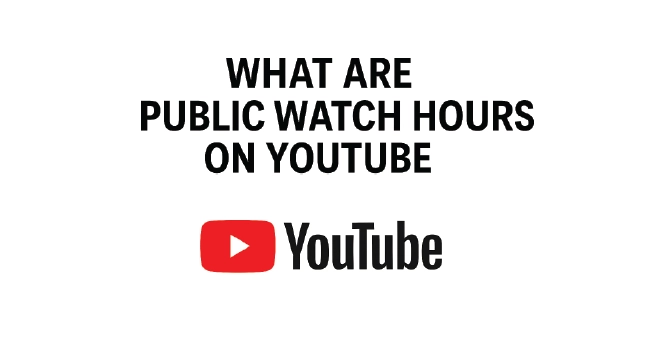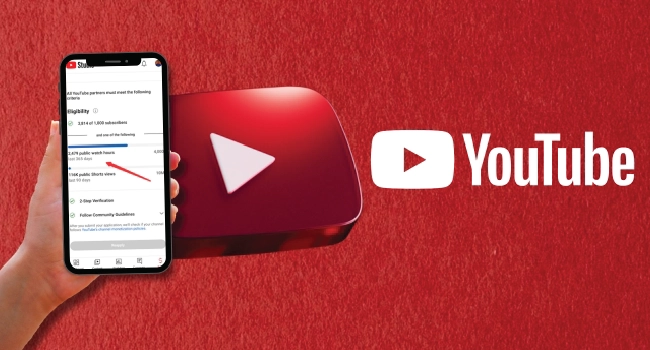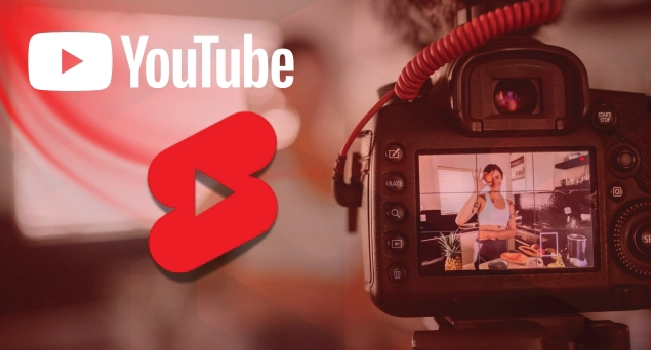
What are public watch hours on YouTube is one of the first questions every new creator asks when thinking about monetization.
If you want to start earning with your channel, you need to understand how watch hours work, what counts toward the requirement, and why YouTube makes such a big deal about them. In this guide, we’ll break it all down in simple terms.
You’ll see exactly how public watch hours are calculated, what doesn’t count, and how you can use them to move closer to joining the YouTube Partner Program.
How Public Watch Hours Affect Monetization (And Why They Matter)
Understanding what are public watch hours on YouTube is only half the story. The bigger question is: why do they matter so much?
-
At 3,000 public hours (with 500 subscribers, in some regions), you can open fan funding tools like Super Chat, Super Stickers, and channel memberships.
-
At 4,000 public hours (plus 1,000 subscribers), you unlock full monetization with ads, along with everything above.
Public watch hours show YouTube that your content attracts real viewers and keeps them engaged. This is why hitting the threshold unlocks key features inside the Partner Program.
Reaching these milestones it's proof that your channel has staying power. That's why YouTube uses public watch hours as one of its main signals before letting you earn directly.
What Are Public Watch Hours on YouTube? (Definition & Rules)

Public watch hours measure how much time viewers spend watching your public content over the past 12 months.
Think of it as a clock that only ticks when people watch videos that anyone can see. YouTube uses this number to decide if you're eligible to earn money.
What counts:
-
Public long-form videos.
-
Livestreams that stay public as replays.
-
Views on embedded public videos (if watched on YouTube).
What doesn't count:
-
Private or unlisted videos.
-
Deleted videos.
-
Paid advertising views.
-
Shorts watched in the Shorts feed (we'll explain this in detail later).
You might notice one number in Analytics and a smaller one in the Monetization tab. That's because Analytics tracks all watch time, but only public watch hours in the Monetization tab matter for the YouTube Partner Program.
For example, if a creator sets a popular video to unlisted, the hours vanish from their eligibility count even if they still see them in Analytics.
The 12-month window also means hours "expire." If a video gave you 500 hours last August, those hours drop off this August. That rolling effect makes it important to keep creating videos that continue to attract new views.
YouTube Partner Program Eligibility Paths
When you ask what are public watch hours on YouTube, the next thing to understand is how they fit into monetization. YouTube gives you two main paths into the Partner Program:
Long-form route
-
At least 1,000 subscribers
-
At least 4,000 valid public watch hours in the last 12 months
Shorts route
-
At least 1,000 subscribers
-
At least 10 million valid Shorts views in the last 90 days
YouTube also introduced an early access tier in some countries. This lets you unlock features like channel memberships and Super Chats with:
-
500 subscribers
-
3 public uploads in the last 90 days
-
Plus either 3,000 public watch hours (12 months) or 3 million Shorts views (90 days)
Full ad revenue still requires the standard thresholds. That's why so many creators search for how many watch hours to monetize YouTube, the simple answer is 4,000, as long as they're valid and public.
Do Shorts and Livestreams Count Toward Public Watch Hours?

A big part of understanding what are public watch hours on YouTube is knowing which types of content actually add to them. This is where many creators get confused.
-
Shorts: The answer to do YouTube shorts count towards watch hours is a little tricky. If your Short is watched in the dedicated Shorts feed, those views don't add to your 4,000 hours. However, if someone watches the same Short on its regular video page, that time may count.
-
Livestreams: Time spent watching live streams can boost your public watch hours, but only if the stream is set to public and you keep the replay visible after it ends. If you delete or unlist the replay, those hours disappear from your total.
This is why many creators focus on a mix of longer videos and live content that stays public. It gives you steady watch time that won't vanish later.
Why Public Watch Hours in Analytics and Monetization Tab Don't Match
Here's why the two numbers don't match:
Analytics totals everything. It includes hours from private, unlisted, or even deleted videos.
Monetization only shows valid hours. It filters out anything that doesn't meet YouTube's rules.
How to Reach 4,000 Public Watch Hours Faster (Legit Methods)
If you want to know how to get 4000 watch hours on YouTube without spending years uploading videos that barely get views. The good news is, you can build watch time faster with a few smart strategies.
-
1. Create longer videos. A 10–15 minute video with good retention builds hours faster than short clips.
-
2. Turn live streams into replays. Keep them public so every replay keeps adding to your total.
-
3. Use playlists. Playlists encourage viewers to watch multiple videos in a row, which increases session time.
-
4. Focus on evergreen topics. Videos that stay relevant over time continue pulling in hours month after month.
If you want to boost results even more, we offer a trusted option to buy YouTube Watch Time. This service delivers real, high-retention hours from genuine accounts, helping you qualify for monetization faster while you keep building content naturally.
How Many Views Do You Need to Reach 4,000 Public Watch Hours?

When people ask what are public watch hours on YouTube, they often want to know what it takes in views to hit the 4,000-hour goal. The math is simple once you break it down.
Formula: (Number of views × Average view duration in minutes) ÷ 60 = Watch hours
Examples:
-
If your videos average 10 minutes, and viewers watch 5 minutes:
48,000 views × 5 minutes ÷ 60 = 4,000 hours -
If your videos average 20 minutes, with viewers staying 10 minutes:
24,000 views × 10 minutes ÷ 60 = 4,000 hours -
If your videos average 3 minutes, watched almost fully:
80,000 views × 3 minutes ÷ 60 = 4,000 hours
Conclusion
Understanding what are public watch hours on YouTube is essential for anyone interested in monetization. These hours are YouTube’s way of measuring meaningful engagement, ensuring that only public, long-form viewing time counts toward eligibility.
They are the foundation of the Partner Program requirements, separating casual uploads from consistent creators.
Whether you aim for the 3,000-hour early access tier or the full 4,000-hour threshold, public watch hours serve as proof that your channel attracts real audiences and sustained attention.
FAQs | Frequently Asked Questions |
How often do public watch hours update in YouTube Studio?
Public watch hours usually update every 24 to 48 hours, though the Monetization tab can sometimes take longer to refresh.
Can deleting a video reduce my public watch hours?
Yes. If you delete a public video, the watch hours it generated will also be removed from your total.
Do views from embedded videos add to my public watch hours?
They can, but only if the viewer watches through YouTube’s player and the video is set to public.
What are public watch hours on YouTube in terms of analytics vs monetization?
In Analytics, you see all watch time. Public watch hours in the Monetization tab only include the eligible hours that count toward monetization.
Do premieres count toward public watch hours?
They do. When viewers watch your premiere live or replay it later, that watch time is added to your public watch hours.
